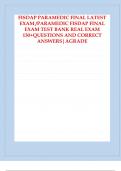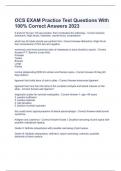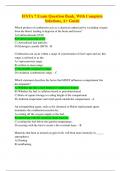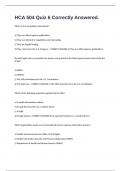FISDAP PARAMEDIC FINAL LATEST EXAM /PARAMEDIC FISDAP FI NAL EXAM TEST BANK REAL EXAM 130+QUESTIONS AND CORRECT ANSWERS|AGRADE If you see a cracked windshield in a MVC... what will the pt represent with? - ans Bruised or lacerated head or face. Brain injury, *cervical spine injury (always until proven otherwise), tracheal injury. If you see a deformed steering column in a MVC... what will the pt represent with? - ans Bruised neck, bruised chest. Sternal or rib fracture, flail chest, myocardial contusion, *pericardial tamponade, pneumo/hemothorax, aortic tear. If you see a deformed dashboard in a MVC... what will the pt represent with? - ans Bruised abdomen, bruised knee, misplaced kneecap. Ruptured spleen, liver, bowel, diaphragm. Fractured patella, dislocated knee, *femoral fracture, dislocated hip. If you se e the rear end of the vehicle is damaged in a MVC... what will the pt represent with? - ans Secondary anterior injuries, esp if the pt wasn't restrained. "Wiplash" injuries, *coup contrecoup injury. Phases of Deceleration - ans 1) Deceleration of the vehi cle, occurs when the vehicle strikes another object & comes to a stop. 2) Deceleration of occupant, which starts during sudden braking & continues through the whole crash. 3) Deceleration of internal organs, that consist of internal organs that continue fo rward momentum until they're stopped by anatomical restraints. 4) Secondary collisions, which occur when a vehicle occupant is hit by objects moving within the vehicle (loose objects). 5) Additional impacts, that the vehicle may receive when it is hit by a second vehicle or is deflected into another. Velocity - ans "Speed kills" - causes more damage than mass. Seat Belt Use - ans All arguments against seat belt use are unfounded. Airbag Injuries - ans Common injuries include abrasions to the face, chest and arms. Minor corrosive effects can occur because of the cornstarch on the airbag, and it may irritate the skin. Down and Under Pathway - ans Occupant slides under the steering wheel or the dash. The knees hit the dashboard, and transmit energy up the le g, to the femur/pelvis. If the feet are locked in place, it can cause femur fractures. Up and Over Pathway - ans Chest hits the steering wheel, head hits the windshield and anterior portion of the throat hits the top of the steering wheel. Can cause signi ficant head and neck injuries. Head on Impact in Motorcycle Crashes - ans Head on impact - motorcycle strikes another object and stops its forward motion, while the rider continues forward motion until stopped by outside force. This causes the rider to go over the handlebars, which causes femur fractures, and tib fractures. Angular Impact in Motorcycle Crashes - ans The motorcycle strikes an object, or another vehicle at an angel so that the rider sustains direct crushing injuries to the lower extremity be tween the object and motorcycle. Motorcycle Crashes - ans With any motorcycle crash, the helmet should be removed carefully if airway management techniques cannot be performed with the helmet in place or the helmet doesn't fit properly on the riders head. Pedestrian Injuries - ans Most pedestrian injuries occur at an intersection, at night. First, the pedestrian is hit in the lower extremities with the cars bumpers. Second, the pedestrian is thrown on the top of the car (resulting in brain injuries, and p elvic fractures. Third, the pedestrian hits the ground or some other object after rolling off the top or the side of the vehicle. Waddell Triad - ans Refers to the pattern of automobile pedestrian injuries in children and people of short stature; 1) bumpe r hits the pelvis/femur instead of the knees, 2) the chest & abdomen hit the grill or low on the hood of the car (sternal & rib fractures), 3) the pt's face hits the hood, then flies back, and hits the ground.







